Douglas Oliver's Diagram Poems
Ralph Hawkins
(click on the diagrams below to view an image which can be enlarged)
Douglas Oliver published Diagram - poems in Ochre Magazine #4 in the late 70's. There are eight poems and eight diagrams - one has to omit the word matching - for matching is the problematic task for both reader and writer. There is also a brief introductory piece carrying the title of the whole. It is this set of poems I wish to write about and not the later The Diagram Poems published in 1979 by The Ferry Press.
Before the commencement of the Diagram - poems, the diagrams on the left, the poems on the right of the page, there is a brief explanatory introduction. Immediately from this we are in confusion, The diagrams describe and transform movements of, but they don't, the words describe or enact or grow from or elaborate a content from the diagrammatic. There are levels of composition and temporality to these poems which define, influence and make their final shape, both visual and textural. Before the diagrammatic there were real events; a series of raids carried out by the Marxist Tupamaro urban guerrillas of Uruguay on key sites in a single town unwitnessed by Oliver, but witnessed as a journalist from afar in Paris. Next, it seems, the poet made a series of maps of these raids. These maps were then turned into a series of diagrammatic cartoon-like drawings. The text then grew from an interaction with the diagrams.
These poems contain the comic and the deadly serious. The diagrams themselves are comic simply because they are so badly and innocently contrived. And in this Ochre version drawn in the poet's hand (the 1979 versions are drawn by David Chaloner), Douglas Oliver also makes them comic through graphic acts of legerdemain. This pictorial conjuring is part of the Diagrams process. My favourites being the magician's poodle made from balloons in P.C., the simplistic yet universal pinman of Arrest, and the explosive pending parturition of Central.
These poems are about key sites but these sites aren't tangible, they are not the buildings the guerrillas want to command, the town they wanted to control, the real estates of money and communication. The key sites for Douglas Oliver are emotive fields, consequences of human actions, decisions and commitments and the way in which we react, confront or negotiate with these fields. Our positive resistance to that which is negative, bad or evil is the revelation of some inner strength or goodness, more likely to be defined in Oliver's work as kindness.
The nature of the initial confusion is of course deliberate; simply events are not what they seem. These poems and diagrams do not record the news events to which they refer in a conventional way simply because in one sense, as Oliver has written, the "theme is the untrustworthiness of what we take to be factual information." In an earlier version in Chicago of 1974 there is an explanatory piece entitled Importantly which states, "Whatever the factual basis for these events, I want to disavow any direct relationship between them and the poem which, in any case, distorts the facts." These events are used to explore the emotive fields brought about by such actions and further explored by the poet's relationship to these happenings and the happenings of the twofold unfolding of the poems and, importantly, his own historiography and experience.
The first poem Team Leader conjures words from two fluid shapes, reminiscent to me of randomly looping string or a complex of knitting patterns.
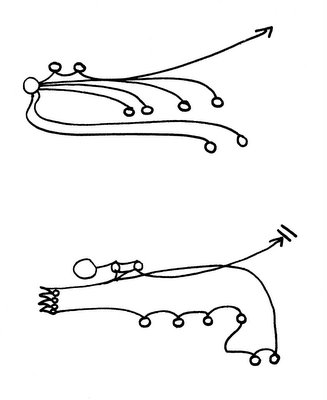
Chicago European Edition 1974
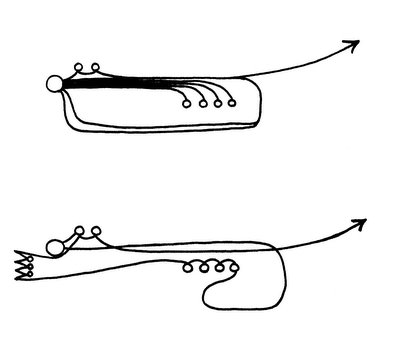
Ochre Magazine #4
Strikingly the words unfold an illustrative landscape from the diagram. Thus within the diagram one can see the articles and accoutrements of the written text. Oliver enumerates a catalogue of holes, spheres and circles - gloves, spectacles, measles, wheels, sleeves, gloves and ring plus a series of words which describe the dynamic of the drawing/s, hurries, looped, slither. In this way we can move easily from the drawing to the text or vice versa - if we wish to. There are also a number of other words in this initial poem which act as thematic indicators on a number of levels. They reverberate not only in the setting, the immediate raid details, but also in the argument Oliver is articulating, an argument his work constantly tries to articulate, from The Harmless Building to his work on the Paris Commune, Whisper 'Louise'. The words are, blood, unlooking, cemetery, arrival, eyes and losses. We can pair up or make oppositions from these words. Emotive movement, prosodic movement and diagrammatic movement become interlinked.
Our access to the complementary and the oppositional meanings of the words is provided through the free flow of interpretation of these doodle diagrams. In this way we can find details in the doodles which are not written about in the text. Strikingly the writing is full of puns and alliterations and what I can only describe as compressed polysemic images. The diagrams likewise are also full of visual puns and visual polysemy. In P.C. the parabolas of flight become a dog. The written word EJECTION on the diagram is the aviator / ejecting from arrowed lines in the poem. EJECTION in the diagram becomes the unwritten but diagrammatic injection of the written vaccinated dog. The word Germs appears around a newly realized drawn nose, a black blob metamorphosing throughout the diagram. The poem like the air is full of sniffs and pointers.
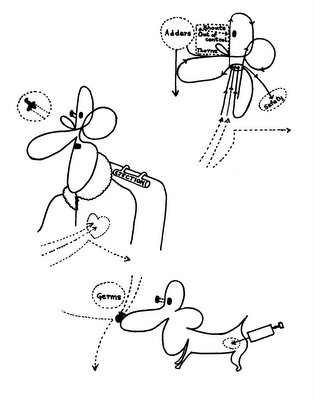
The diagrammatic emphasis of these cartoons is stressed by a proliferative use of arrow indicators. Remarkably, Fire Station is arrow free. This becomes the most radically changed diagram in the 1979 version. Unflying birds squibble the page. To my untrained eye these birds must be identifiable, one chicken, one turkey but I'm not sure what they are or if they have any significance other than being diagrammatically flightless - Ill wings tide down. The word ill flying straight back to the germs and precautionary vaccination of the previous poem. Thus the Fire Station becomes a location for the opposites of health and sickness, tying into the themes of birth and death and the related occurrences in the text of entrance and exit, arrival and departure.
But if we haven't noticed it yet the Fire Station reveals one of the major preoccupations of these poems, the debate between the external ear / eye and the internal ear / eye. What we see and experience against what we think and do about what we hear and see. To Oliver this would be how we conduct the self - how to act ethically and morally and how we defend and define what is moral and / or ethical.
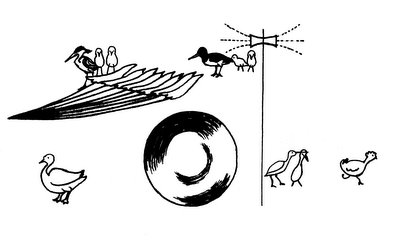
This poem batters away with an axe-tannoy through a text laden with metaphorical alarms. The earlier unlooking of Team Leader has become the blank of the eye, the not noticing and unaware, not only on a political level, men and women, women and men here now / but some in appalling prisons but also on a deeply personal level, relationship with and between mother and father, parents and children, announces the ignored years between us and the fire station at grand cries. Thought-acts are at large throughout in the contrast between good thoughts and bad, the arrow of a bad thought pell-mell towards torture. Thinking badly is as negative as thinking grandly; this is part of the final poem's declaration. A personal unlocking is directed towards ourselves and our conduct / behaviour and on a larger scale of how we look at the world of others.
It is apposite to note the worked oppositions in this poem and their further thematic uncovering / discovering and recovering in the what has been and the what is to come. Again past (birth / death) and future (death / birth) are at the threshold of each moment. They ring our lives. They are the tunnels through which the poem moves.
Fire Station, through the tannoy, assaults our listening and seeing with the words, speaks, chimes, clarion, the blank of the eye, eye, rung, bell, ring, clucking, clapper, screeching, scratchy, announces, cries.
There is also the juxtaposition of ear through story, a different story than the one we're in / an old story, and eye, through picture, Not yet in the picture. As we discover with the Diagram-poems the content of the picture tells a different story to that of the content of the writing. Both contents plus their interactions tie together the imagined and the real. Hearing is both literal and figurative, but true hearing is somehow locked within us and yet can be made accessible. Its accessibility is thus on the edge of being.
If we return to Team Leader we discover the first indicators of a notion of internality which runs throughout this work, a depth to which Oliver is in the process of coming to terms with. They are the word internal itself (the final words of the poems are in us) primarily connecting to the texts and the written emotive fields and Starting from a ring of arrival which interlinks the (diagrammatic) visual with the written through a variety of symbols. Starting from a ring of arrival is itself an example of a compressed polysemy, tying into the themes of birth and death and the movements and journeys of the fabricated and real.
Within the borders of feeling lies a deeper knowledge, a process of hearing feeling, that I am my children, / in me their voice breaks with ear knowledge. Understanding feeling, and feeling's part of my work, is part of this work's archaeological exploration, identifying the inarticulate figurative from which good can emerge. Hidden away in the parenthesis of the final diagram is P.C., agent, journalists, help to save some suffering.
One course of action for Oliver is to address the subject of suffering through his work - and likewise to alleviate and understand 'suffering' in one's daily life. Suffering on the larger scale is difficult to address or resolve on a personal level because of a disconnection in aggregates of power, political and economic agendas which are not ours. Here we are powerless. But it is possible to help, care, provide on an immediate level through the daily conduct of being. As Oliver writes in Central - I'd like to have friends on these streets, friends / who'd look for me in creations of total emergency / in or out of dreams.
Looking at the drawing accompanying Central we are presented with what appear to be pulled Christmas crackers and a loud visual pop or bang. There are open scissors, a pregnant woman (twice), arrows indicating an old man (twice?), a young boy, what looks to me like an eye and a smaller explosion or wig. The small Christmas crackers are communicative, they are umbilici, they are severed links.
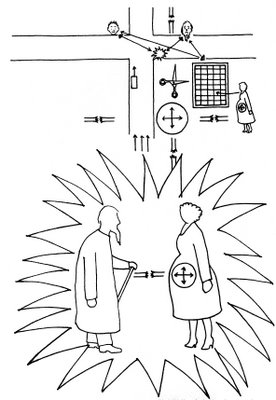
Central is a telephone exchange. The diagram drawings translate into a plethora of connectives. Central becomes the womb (birth) and jellyroll is itself part of joining and connection. The drawn Christmas crackers are links, to our past, to our memories, to feelings. The crackers in the text become cut cables (disconnecting), severed links, the end of the line (death), fading, cut dead. Cut becomes a link, somewhat cinematic, dreamlike. . . Cut. . . A guerrilla command tone. Cut, as command could also be caesarean, Place the pregnant / woman. The drawn open scissors are poised to cut the umbilicus. Everything seems to mean itself and something else. The multilayering and interweaving (not only of this poem but of the poems as unitary) invite us into an amalgam of word and image, the aural and visual. We are orientated through disorientation. We are trying to find our way. One last command from the poet is to, Cut other connections yourself but / obey the voices that come from long distance, obey sound and feeling. Feeling translates as care and good. The long distance is somewhere deep inside us.
Thus the poem literally cuts back to Tom. But Tom's no longer there. Tom was my son. Tom is the embodiment of memory, feeling and innocence. Tom being Oliver's child who died at an early age. The Christmas crackers have been pulled apart in the poem and they were meant to be so. Faced with the dilemmas of birth and death we try to reconnect severed links.
These natural extremes are at the centrality of our most powerful and inner feelings. Is Oliver saying we should draw on these feelings to understand (hear/see) the true loss of others? This understanding is not sympathy or empathy (but obviously without these we would have no understanding) because some of these losses involve the victims of political assault by the state and those who violently oppose the state - terrorists or guerrillas. Is Oliver saying we should address these issues through our acts or actions whatever they may or can be? That there is a good to oppose evil?
Hearing and seeing are predominant to understanding but in the poem these senses (in a sense) are not literal, they are in turns cerebral (or intellectual) and gut wrenching. They are undoubtedly inner. There are internal sounds. There is ear knowledge. Hearing, knowledge and understanding go together. But hearing and seeing are also problematic and perhaps demand understanding (knowledge). In the poems the eye therefore needs medicine and the ear needs an earpiece. Ears can see and eyes can hear.
In Arrest damage to the ear affects hearing so totally that we fail to hear sufficiently of the true loss. . . the gone sick, the suicidal deafness, and, finally / the arrest when the heart's no longer heard in the ear. The complexities of meaning in the last line tie into not only the comic activities of the robberies, kidnaps and subterfuges and the descriptive literalness of these events as they unfold their narrativities and teleologies (what will happen, textural and diagrammatic arrows pointing to the conclusive cemetery), but also to Oliver's metaphoric text and the figurative implications of deafness and blindness. That part of the poem which deals with softness, feeling, kindness and innocence. Arrest is a multivalent word.
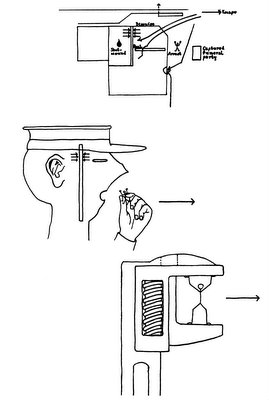
The diagram of Arrest is interesting in the way a visual text can enact a metaphoric process. As invention, change and connection are part of the writing (and the writing itself having a relationship and inter-relationship with the visual) so too does the visual transform itself making connections as it proceeds. The diagram of Arrest is in three parts. What looks like a] an electrical circuit diagram, b] a hatted head and c] an adjustable spanner. We can find words in the text to match these, a] translates as the pun drawn in the diagram, b] could be the nominalist / who likes real heads on his coins, and / or the disguised P.C. / looks a bit like "Serving us", the many headed dog (the pinman seemingly to have circular hands to match his head) and c] the punning the span of life so inevitable and yet adjustable. But there are also common elements to the drawings. The parallel vertical lines and six small arrows of a] become a strap for the hat, the arrows perhaps lines or furrows by the eye. A semi-circular dent in a] becomes a policeman's mouth in b] and the adjustable mouth of the spanner in c] and the head of the policeman has become the head of the spanner and the frown line arrows have become the spiral which adjusts the spanner head. Besides the pinman, whose hands are always up in surrender, the arrow of Escape in a] is present in b] and c] presumably relating to the no escape of being eaten, the real heads . . . of flesh of the text and the no escape of being crushed to death by the jaws of the spanner.
On the other side of softness (innocence) is cruelty - incarceration, torture, bestiality, sadism. Within the Diagram-Poems softness is located in positive relationships, mother and child of the kidnap, Tom, and his present family of my children.
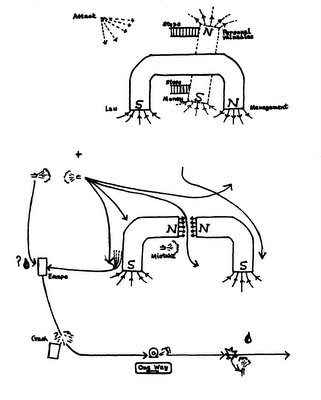
These children are the locus for the poem U which operates on many temporal levels (temporality as a feature and as a phenomenological event connected to the acts and decisions of lived experience and theoretical prosody is detailed, used and explicated within the text of the whole). The prosodic movements are dictated through emotive force, that feeling Oliver refers to as part of his work. The lines are heartfelt but they are also worked. The moments of textural composition, a present, a future and their resolution, project into the as yet not written (this is partly born from an elective narration - they are what has already happened in a different form and in a different time zone, the pre-events of the poem). For example in Central we have the present written moment of, place the pregnant / woman into temporary prison → go to the future Gold and discover prison is now new present temporary stir, adding the significance of prison and agitation. The poem Gold in turn looks forward to the poem U, to the next bank of troubles, money as magnet / diagram unlucky seven. U is the seventh poem of the sequence. And in U Capital itself comes under assault. Mao's phrase about power coming from the barrel of a gun seems fitting - waves the muzzle where all the arrows / of acquisition, law and management have come and gone.
Gold in turn carries within it a multilayering both forwards and backwards in time connecting events and themes, this arrow stuttering on as the plan itself grows. Gold as a precious metal and its associative power and liquid constituency is played with on a number of fronts, banks / money - robbery / fear, banks of dread - money as liquid (smelted gold), cordial, gilt liquid can be siphoned off, robbed / stolen - banks of dread becomes bag of troubles and then bank of troubles - the metal of money becomes magnetic attracting the robbers - the banks of dread become the fear of the policeman and gold in physic is just a cordial and gilt liquid is taken off returns to the issues of (moral health), sickness and well being.
Magnates, magnets, management and managers are melopoetically and ideologically conjoined. Finance is a force field controlled through laws and practice by the state. These manipulative hierarchies, in the situations described by the poem, result in causalities of the innocent. But the true effects of capital are more widespread and likewise hidden. Capital here is under direct acquisitive attack by an anti-capitalist group, drawing attention to the complex of motives, acts, thoughts and emotions of those caught up in such dramas; innocents, guardians and perpetrators. The poem in this way highlights the emotive structures which are usually inert in our daily lives but are hidden within us. Thus our resources of kindness seem only to expose themselves in extremis - on the border or the gap of the bridge of life and death.
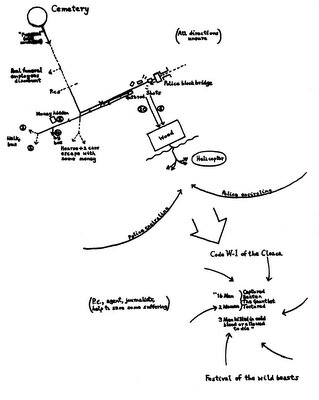
The final poem The Diagonal is Diagonal bears only a slight relationship to the accompanying diagram. All the diagrams up to this last poem contain elements which are included in the text - some more than others and in the vast majority of diagrams the movements or contents can be found within the text - or can be interpreted by the text. In such a highly elaborate writing Oliver has utilized processes of chance and accident (issues again of temporality) thrown up by and through the diagrams. The police encircling lines aren't buttocks neither would they be drawn so but they are 'accidentally' so. This final diagram returns me to my initial confusion (confusion, accident and chance are part of what occurs through he actual events described). All directions (are) unsure because of the amount of diagrammatic information which is absent from the poem. Why is the diagram littered with numbers? Is the cemetery a zero? Circles can be found more or less throughout the poem. Do the numbers relate to the victims, guerrillas and police? But the numbers don't account for everyone, there are unnumbered people in Hearse + 2 cars escape with some money. Why are some of the diagrammatic elements written when they perhaps could have been easily drawn?
The final poem does come full circle. It is certainly striated; each poem-band leaking and admixing between layers. The opening Slowness of gaze brings us back to looking, slowness and fastness bring us back to temporality and movement - movement brings us back to the diagrammatic flows and the diagrammatic returns us to this poem and all the other poems for this work is nothing without the original movements, which in turn returns us to the pre-event of the poems, the activities of the Tupamaro.
The lack of text on the diagrammatic is commented on within the text, The diagram could again spring a picture / encircling looks like buttocks, / there's a cloaca. Wolves. And that more or less is the totality of the written relationship between the text and diagram of this last poem. Indeed they appear to be unrelated - the visual doesn't feed into the written and the written doesn't feed into the visual. But this again might be misleading because The Diagonal is the Diagonal is by far the longest, most complicated and challenging of all the poems. It is the outcome poem and it not only reiterates much of what has gone before but also seems to question it. Here Oliver interrogates the Diagram - poems making and content, the ways in which the whole developed, grew and progressed. The self is looked at in its multiples or parts, the Parisian journalist, the academic, the father and the poet or controlling I of the poem - the assembler. The place of reassembly in the cemetery / really is the cemetery.
The poem is then briefly reassembled in its sequential order,
The implications of this final poem and this set of poems is forever problematic for me. The deliberate disorientating nature of the central question or questions is at once vast and singular. I'm not even sure I've read the questions of life and death, and the living of one's life, correctly - but I do know from this text and the body of Oliver's work that these are thematic and obsessive issues. The movements described or enacted throughout by the separate and conjoined text and diagrams will never be complete.
(click on the diagrams below to view an image which can be enlarged)
Douglas Oliver published Diagram - poems in Ochre Magazine #4 in the late 70's. There are eight poems and eight diagrams - one has to omit the word matching - for matching is the problematic task for both reader and writer. There is also a brief introductory piece carrying the title of the whole. It is this set of poems I wish to write about and not the later The Diagram Poems published in 1979 by The Ferry Press.
Before the commencement of the Diagram - poems, the diagrams on the left, the poems on the right of the page, there is a brief explanatory introduction. Immediately from this we are in confusion, The diagrams describe and transform movements of, but they don't, the words describe or enact or grow from or elaborate a content from the diagrammatic. There are levels of composition and temporality to these poems which define, influence and make their final shape, both visual and textural. Before the diagrammatic there were real events; a series of raids carried out by the Marxist Tupamaro urban guerrillas of Uruguay on key sites in a single town unwitnessed by Oliver, but witnessed as a journalist from afar in Paris. Next, it seems, the poet made a series of maps of these raids. These maps were then turned into a series of diagrammatic cartoon-like drawings. The text then grew from an interaction with the diagrams.
These poems contain the comic and the deadly serious. The diagrams themselves are comic simply because they are so badly and innocently contrived. And in this Ochre version drawn in the poet's hand (the 1979 versions are drawn by David Chaloner), Douglas Oliver also makes them comic through graphic acts of legerdemain. This pictorial conjuring is part of the Diagrams process. My favourites being the magician's poodle made from balloons in P.C., the simplistic yet universal pinman of Arrest, and the explosive pending parturition of Central.
These poems are about key sites but these sites aren't tangible, they are not the buildings the guerrillas want to command, the town they wanted to control, the real estates of money and communication. The key sites for Douglas Oliver are emotive fields, consequences of human actions, decisions and commitments and the way in which we react, confront or negotiate with these fields. Our positive resistance to that which is negative, bad or evil is the revelation of some inner strength or goodness, more likely to be defined in Oliver's work as kindness.
The nature of the initial confusion is of course deliberate; simply events are not what they seem. These poems and diagrams do not record the news events to which they refer in a conventional way simply because in one sense, as Oliver has written, the "theme is the untrustworthiness of what we take to be factual information." In an earlier version in Chicago of 1974 there is an explanatory piece entitled Importantly which states, "Whatever the factual basis for these events, I want to disavow any direct relationship between them and the poem which, in any case, distorts the facts." These events are used to explore the emotive fields brought about by such actions and further explored by the poet's relationship to these happenings and the happenings of the twofold unfolding of the poems and, importantly, his own historiography and experience.
The first poem Team Leader conjures words from two fluid shapes, reminiscent to me of randomly looping string or a complex of knitting patterns.

Chicago European Edition 1974

Ochre Magazine #4
Strikingly the words unfold an illustrative landscape from the diagram. Thus within the diagram one can see the articles and accoutrements of the written text. Oliver enumerates a catalogue of holes, spheres and circles - gloves, spectacles, measles, wheels, sleeves, gloves and ring plus a series of words which describe the dynamic of the drawing/s, hurries, looped, slither. In this way we can move easily from the drawing to the text or vice versa - if we wish to. There are also a number of other words in this initial poem which act as thematic indicators on a number of levels. They reverberate not only in the setting, the immediate raid details, but also in the argument Oliver is articulating, an argument his work constantly tries to articulate, from The Harmless Building to his work on the Paris Commune, Whisper 'Louise'. The words are, blood, unlooking, cemetery, arrival, eyes and losses. We can pair up or make oppositions from these words. Emotive movement, prosodic movement and diagrammatic movement become interlinked.
Our access to the complementary and the oppositional meanings of the words is provided through the free flow of interpretation of these doodle diagrams. In this way we can find details in the doodles which are not written about in the text. Strikingly the writing is full of puns and alliterations and what I can only describe as compressed polysemic images. The diagrams likewise are also full of visual puns and visual polysemy. In P.C. the parabolas of flight become a dog. The written word EJECTION on the diagram is the aviator / ejecting from arrowed lines in the poem. EJECTION in the diagram becomes the unwritten but diagrammatic injection of the written vaccinated dog. The word Germs appears around a newly realized drawn nose, a black blob metamorphosing throughout the diagram. The poem like the air is full of sniffs and pointers.

The diagrammatic emphasis of these cartoons is stressed by a proliferative use of arrow indicators. Remarkably, Fire Station is arrow free. This becomes the most radically changed diagram in the 1979 version. Unflying birds squibble the page. To my untrained eye these birds must be identifiable, one chicken, one turkey but I'm not sure what they are or if they have any significance other than being diagrammatically flightless - Ill wings tide down. The word ill flying straight back to the germs and precautionary vaccination of the previous poem. Thus the Fire Station becomes a location for the opposites of health and sickness, tying into the themes of birth and death and the related occurrences in the text of entrance and exit, arrival and departure.
But if we haven't noticed it yet the Fire Station reveals one of the major preoccupations of these poems, the debate between the external ear / eye and the internal ear / eye. What we see and experience against what we think and do about what we hear and see. To Oliver this would be how we conduct the self - how to act ethically and morally and how we defend and define what is moral and / or ethical.

This poem batters away with an axe-tannoy through a text laden with metaphorical alarms. The earlier unlooking of Team Leader has become the blank of the eye, the not noticing and unaware, not only on a political level, men and women, women and men here now / but some in appalling prisons but also on a deeply personal level, relationship with and between mother and father, parents and children, announces the ignored years between us and the fire station at grand cries. Thought-acts are at large throughout in the contrast between good thoughts and bad, the arrow of a bad thought pell-mell towards torture. Thinking badly is as negative as thinking grandly; this is part of the final poem's declaration. A personal unlocking is directed towards ourselves and our conduct / behaviour and on a larger scale of how we look at the world of others.
It is apposite to note the worked oppositions in this poem and their further thematic uncovering / discovering and recovering in the what has been and the what is to come. Again past (birth / death) and future (death / birth) are at the threshold of each moment. They ring our lives. They are the tunnels through which the poem moves.
Fire Station, through the tannoy, assaults our listening and seeing with the words, speaks, chimes, clarion, the blank of the eye, eye, rung, bell, ring, clucking, clapper, screeching, scratchy, announces, cries.
There is also the juxtaposition of ear through story, a different story than the one we're in / an old story, and eye, through picture, Not yet in the picture. As we discover with the Diagram-poems the content of the picture tells a different story to that of the content of the writing. Both contents plus their interactions tie together the imagined and the real. Hearing is both literal and figurative, but true hearing is somehow locked within us and yet can be made accessible. Its accessibility is thus on the edge of being.
If we return to Team Leader we discover the first indicators of a notion of internality which runs throughout this work, a depth to which Oliver is in the process of coming to terms with. They are the word internal itself (the final words of the poems are in us) primarily connecting to the texts and the written emotive fields and Starting from a ring of arrival which interlinks the (diagrammatic) visual with the written through a variety of symbols. Starting from a ring of arrival is itself an example of a compressed polysemy, tying into the themes of birth and death and the movements and journeys of the fabricated and real.
Within the borders of feeling lies a deeper knowledge, a process of hearing feeling, that I am my children, / in me their voice breaks with ear knowledge. Understanding feeling, and feeling's part of my work, is part of this work's archaeological exploration, identifying the inarticulate figurative from which good can emerge. Hidden away in the parenthesis of the final diagram is P.C., agent, journalists, help to save some suffering.
One course of action for Oliver is to address the subject of suffering through his work - and likewise to alleviate and understand 'suffering' in one's daily life. Suffering on the larger scale is difficult to address or resolve on a personal level because of a disconnection in aggregates of power, political and economic agendas which are not ours. Here we are powerless. But it is possible to help, care, provide on an immediate level through the daily conduct of being. As Oliver writes in Central - I'd like to have friends on these streets, friends / who'd look for me in creations of total emergency / in or out of dreams.
Looking at the drawing accompanying Central we are presented with what appear to be pulled Christmas crackers and a loud visual pop or bang. There are open scissors, a pregnant woman (twice), arrows indicating an old man (twice?), a young boy, what looks to me like an eye and a smaller explosion or wig. The small Christmas crackers are communicative, they are umbilici, they are severed links.

Central is a telephone exchange. The diagram drawings translate into a plethora of connectives. Central becomes the womb (birth) and jellyroll is itself part of joining and connection. The drawn Christmas crackers are links, to our past, to our memories, to feelings. The crackers in the text become cut cables (disconnecting), severed links, the end of the line (death), fading, cut dead. Cut becomes a link, somewhat cinematic, dreamlike. . . Cut. . . A guerrilla command tone. Cut, as command could also be caesarean, Place the pregnant / woman. The drawn open scissors are poised to cut the umbilicus. Everything seems to mean itself and something else. The multilayering and interweaving (not only of this poem but of the poems as unitary) invite us into an amalgam of word and image, the aural and visual. We are orientated through disorientation. We are trying to find our way. One last command from the poet is to, Cut other connections yourself but / obey the voices that come from long distance, obey sound and feeling. Feeling translates as care and good. The long distance is somewhere deep inside us.
Thus the poem literally cuts back to Tom. But Tom's no longer there. Tom was my son. Tom is the embodiment of memory, feeling and innocence. Tom being Oliver's child who died at an early age. The Christmas crackers have been pulled apart in the poem and they were meant to be so. Faced with the dilemmas of birth and death we try to reconnect severed links.
These natural extremes are at the centrality of our most powerful and inner feelings. Is Oliver saying we should draw on these feelings to understand (hear/see) the true loss of others? This understanding is not sympathy or empathy (but obviously without these we would have no understanding) because some of these losses involve the victims of political assault by the state and those who violently oppose the state - terrorists or guerrillas. Is Oliver saying we should address these issues through our acts or actions whatever they may or can be? That there is a good to oppose evil?
Hearing and seeing are predominant to understanding but in the poem these senses (in a sense) are not literal, they are in turns cerebral (or intellectual) and gut wrenching. They are undoubtedly inner. There are internal sounds. There is ear knowledge. Hearing, knowledge and understanding go together. But hearing and seeing are also problematic and perhaps demand understanding (knowledge). In the poems the eye therefore needs medicine and the ear needs an earpiece. Ears can see and eyes can hear.
In Arrest damage to the ear affects hearing so totally that we fail to hear sufficiently of the true loss. . . the gone sick, the suicidal deafness, and, finally / the arrest when the heart's no longer heard in the ear. The complexities of meaning in the last line tie into not only the comic activities of the robberies, kidnaps and subterfuges and the descriptive literalness of these events as they unfold their narrativities and teleologies (what will happen, textural and diagrammatic arrows pointing to the conclusive cemetery), but also to Oliver's metaphoric text and the figurative implications of deafness and blindness. That part of the poem which deals with softness, feeling, kindness and innocence. Arrest is a multivalent word.

The diagram of Arrest is interesting in the way a visual text can enact a metaphoric process. As invention, change and connection are part of the writing (and the writing itself having a relationship and inter-relationship with the visual) so too does the visual transform itself making connections as it proceeds. The diagram of Arrest is in three parts. What looks like a] an electrical circuit diagram, b] a hatted head and c] an adjustable spanner. We can find words in the text to match these, a] translates as the pun drawn in the diagram, b] could be the nominalist / who likes real heads on his coins, and / or the disguised P.C. / looks a bit like "Serving us", the many headed dog (the pinman seemingly to have circular hands to match his head) and c] the punning the span of life so inevitable and yet adjustable. But there are also common elements to the drawings. The parallel vertical lines and six small arrows of a] become a strap for the hat, the arrows perhaps lines or furrows by the eye. A semi-circular dent in a] becomes a policeman's mouth in b] and the adjustable mouth of the spanner in c] and the head of the policeman has become the head of the spanner and the frown line arrows have become the spiral which adjusts the spanner head. Besides the pinman, whose hands are always up in surrender, the arrow of Escape in a] is present in b] and c] presumably relating to the no escape of being eaten, the real heads . . . of flesh of the text and the no escape of being crushed to death by the jaws of the spanner.
On the other side of softness (innocence) is cruelty - incarceration, torture, bestiality, sadism. Within the Diagram-Poems softness is located in positive relationships, mother and child of the kidnap, Tom, and his present family of my children.

These children are the locus for the poem U which operates on many temporal levels (temporality as a feature and as a phenomenological event connected to the acts and decisions of lived experience and theoretical prosody is detailed, used and explicated within the text of the whole). The prosodic movements are dictated through emotive force, that feeling Oliver refers to as part of his work. The lines are heartfelt but they are also worked. The moments of textural composition, a present, a future and their resolution, project into the as yet not written (this is partly born from an elective narration - they are what has already happened in a different form and in a different time zone, the pre-events of the poem). For example in Central we have the present written moment of, place the pregnant / woman into temporary prison → go to the future Gold and discover prison is now new present temporary stir, adding the significance of prison and agitation. The poem Gold in turn looks forward to the poem U, to the next bank of troubles, money as magnet / diagram unlucky seven. U is the seventh poem of the sequence. And in U Capital itself comes under assault. Mao's phrase about power coming from the barrel of a gun seems fitting - waves the muzzle where all the arrows / of acquisition, law and management have come and gone.
Gold in turn carries within it a multilayering both forwards and backwards in time connecting events and themes, this arrow stuttering on as the plan itself grows. Gold as a precious metal and its associative power and liquid constituency is played with on a number of fronts, banks / money - robbery / fear, banks of dread - money as liquid (smelted gold), cordial, gilt liquid can be siphoned off, robbed / stolen - banks of dread becomes bag of troubles and then bank of troubles - the metal of money becomes magnetic attracting the robbers - the banks of dread become the fear of the policeman and gold in physic is just a cordial and gilt liquid is taken off returns to the issues of (moral health), sickness and well being.
Magnates, magnets, management and managers are melopoetically and ideologically conjoined. Finance is a force field controlled through laws and practice by the state. These manipulative hierarchies, in the situations described by the poem, result in causalities of the innocent. But the true effects of capital are more widespread and likewise hidden. Capital here is under direct acquisitive attack by an anti-capitalist group, drawing attention to the complex of motives, acts, thoughts and emotions of those caught up in such dramas; innocents, guardians and perpetrators. The poem in this way highlights the emotive structures which are usually inert in our daily lives but are hidden within us. Thus our resources of kindness seem only to expose themselves in extremis - on the border or the gap of the bridge of life and death.

The final poem The Diagonal is Diagonal bears only a slight relationship to the accompanying diagram. All the diagrams up to this last poem contain elements which are included in the text - some more than others and in the vast majority of diagrams the movements or contents can be found within the text - or can be interpreted by the text. In such a highly elaborate writing Oliver has utilized processes of chance and accident (issues again of temporality) thrown up by and through the diagrams. The police encircling lines aren't buttocks neither would they be drawn so but they are 'accidentally' so. This final diagram returns me to my initial confusion (confusion, accident and chance are part of what occurs through he actual events described). All directions (are) unsure because of the amount of diagrammatic information which is absent from the poem. Why is the diagram littered with numbers? Is the cemetery a zero? Circles can be found more or less throughout the poem. Do the numbers relate to the victims, guerrillas and police? But the numbers don't account for everyone, there are unnumbered people in Hearse + 2 cars escape with some money. Why are some of the diagrammatic elements written when they perhaps could have been easily drawn?
The final poem does come full circle. It is certainly striated; each poem-band leaking and admixing between layers. The opening Slowness of gaze brings us back to looking, slowness and fastness bring us back to temporality and movement - movement brings us back to the diagrammatic flows and the diagrammatic returns us to this poem and all the other poems for this work is nothing without the original movements, which in turn returns us to the pre-event of the poems, the activities of the Tupamaro.
The lack of text on the diagrammatic is commented on within the text, The diagram could again spring a picture / encircling looks like buttocks, / there's a cloaca. Wolves. And that more or less is the totality of the written relationship between the text and diagram of this last poem. Indeed they appear to be unrelated - the visual doesn't feed into the written and the written doesn't feed into the visual. But this again might be misleading because The Diagonal is the Diagonal is by far the longest, most complicated and challenging of all the poems. It is the outcome poem and it not only reiterates much of what has gone before but also seems to question it. Here Oliver interrogates the Diagram - poems making and content, the ways in which the whole developed, grew and progressed. The self is looked at in its multiples or parts, the Parisian journalist, the academic, the father and the poet or controlling I of the poem - the assembler. The place of reassembly in the cemetery / really is the cemetery.
The poem is then briefly reassembled in its sequential order,
. . .to that other startWhat follows is a questioning of courage - that, I think, it should remain adulterated - in a sense unmotivated - as far as is possible. We should, as individuals address our relationships and responsibilities with death both on a personal and a political level. The final line, grace and courage arrive calmly in us is then what I interpret, unnervingly and uneasily, as the call of the poem.
from which team leader became a finger pointing left
that's audience left. . .
In the known risk then
an airman became a dog
firemen were pegged down as birds of fire
the baby in the womb was old
the pinman strained against the spanner
if you could only believe he'd hold that posture
an arrow filled with gold
the magnet power of money failed
as the magnet power of luck did. . .
all these started in the drawings. . .
The implications of this final poem and this set of poems is forever problematic for me. The deliberate disorientating nature of the central question or questions is at once vast and singular. I'm not even sure I've read the questions of life and death, and the living of one's life, correctly - but I do know from this text and the body of Oliver's work that these are thematic and obsessive issues. The movements described or enacted throughout by the separate and conjoined text and diagrams will never be complete.